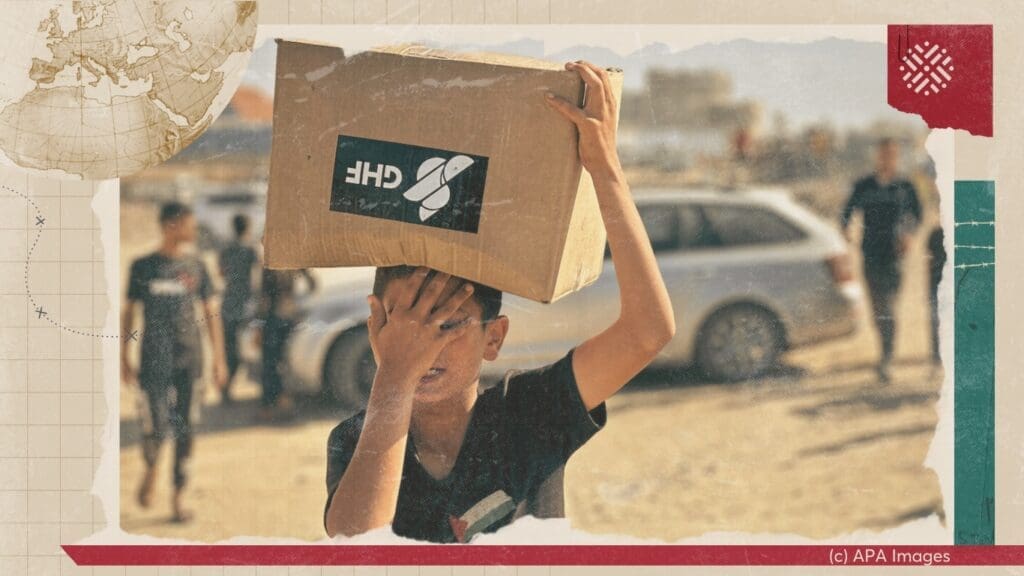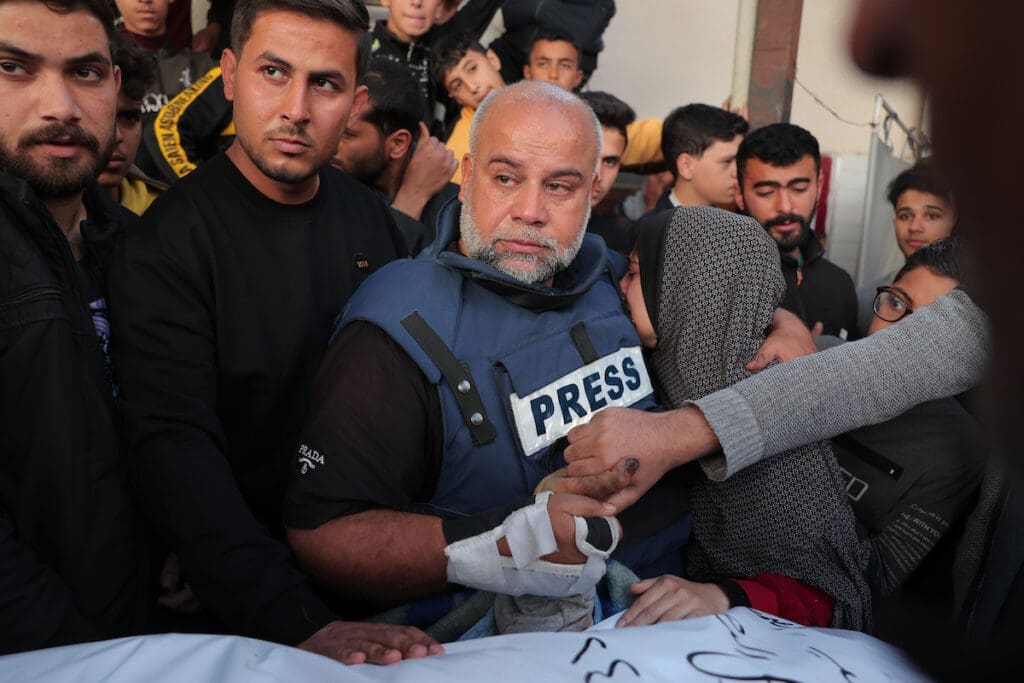- Topics
-
Topics
See our analysis on civil society and how it shapes culture, politics, and policies
Read our insights on the shifting political landscape and what it means for Palestine
Learn more about the policies and practices shaping the Palestinian economy
Strengthen your understanding of the unique conditions for Palestinian refugees across the Middle East
-
- Analysis
-
Analysis
In-depth analysis on existing or potential policies that impact possibilities for Palestinian liberation.
Insights and perspectives on social, political, and economic questions related to Palestine and Palestinians globally.
Concise analysis into a specific policy, its background and implications.
Commentary that brings together insights from multiple analysts.
Compilations of past Al-Shabaka works surrounding a specific theme.
Longer-form, ad hoc projects that seek to confront research questions outside the scope of our regular analysis.
A policy-driven research initiative by Al-Shabaka: The Palestinian Policy Network.
Our monthly webinar series that brings together Palestinian experts.
Featured
On Thursday, June 19, 2025, Israeli Prime Minister Benjamin Netanyahu stood in front of the aftermath of an Iranian strike near Bir al-Saba’ and told journalists: “It really reminds me of the British people during the Blitz. We are going through a Blitz.” The Blitz refers to the sustained bombing campaign carried out by Nazi Germany against the UK, particularly London, between September 1940 and May 1941. With this dramatic comparison, Netanyahu sought to elicit Western sympathy and secure unconditional support for his government’s latest act of military escalation and violation of international law: the unprovoked bombing of Iran. This rhetorical move is far from new; it has become an enduring trope in Israeli political discourse—one that casts Israel as the perennial victim and frames its opponents as modern-day Nazis. Netanyahu has long harbored ambitions of striking Iran with direct US support, but timing has always been central. This moment, then, should not be viewed merely as opportunistic aggression, but as part of a broader, calculated strategy. His actions are shaped by a convergence of unprecedented impunity, shifting regional dynamics, and deepening domestic political fragility. This commentary examines the latest escalation in that context and discusses the broader political forces driving it. Yara Hawari· Jun 26, 2025Launched on May 26, 2025, and secured by US private contractors, the new Israeli-backed aid distribution system in Gaza has resulted in over 100 Palestinian deaths, as civilians navigated dangerous conditions at hubs positioned near military outposts along the Rafah border. These fatalities raise grave concerns about the safety of the aid model and the role of US contractors operating under Israeli oversight. This policy memo argues that the privatization of aid and security in Gaza violates humanitarian norms by turning aid into a tool of control, ethnic cleansing, and colonization. It threatens Palestinian life by conditioning life-saving aid, facilitating forced displacement, and shielding the Israeli regime from legal and moral responsibility. It additionally erodes local and international institutions, especially UNRWA, which has been working in Gaza for decades.
Yara Hawari· Jun 26, 2025Launched on May 26, 2025, and secured by US private contractors, the new Israeli-backed aid distribution system in Gaza has resulted in over 100 Palestinian deaths, as civilians navigated dangerous conditions at hubs positioned near military outposts along the Rafah border. These fatalities raise grave concerns about the safety of the aid model and the role of US contractors operating under Israeli oversight. This policy memo argues that the privatization of aid and security in Gaza violates humanitarian norms by turning aid into a tool of control, ethnic cleansing, and colonization. It threatens Palestinian life by conditioning life-saving aid, facilitating forced displacement, and shielding the Israeli regime from legal and moral responsibility. It additionally erodes local and international institutions, especially UNRWA, which has been working in Gaza for decades. Safa Joudeh· Jun 10, 2025In this policy lab, Mariam Barghouti and Sharif Abdel Kouddous join host Tariq Kenney-Shawa to discuss Israel’s targeted assassination campaign against Palestinian journalists, the complicity of Western media in normalizing these crimes, and how this silence allows Israel to get away with genocide.
Safa Joudeh· Jun 10, 2025In this policy lab, Mariam Barghouti and Sharif Abdel Kouddous join host Tariq Kenney-Shawa to discuss Israel’s targeted assassination campaign against Palestinian journalists, the complicity of Western media in normalizing these crimes, and how this silence allows Israel to get away with genocide. Mariam Barghouti· May 28, 2025
Mariam Barghouti· May 28, 2025
-
- Resources
- Media & Outreach
- The Network




An Inevitable Rupture: Al-Aqsa Flood and the End of Partition
Hamas’s surprise offensive on October 7th, 2023, dealt the most lethal blow to the Israeli military and public since the establishment of the state in 1948. In retaliation, Israel launched the most extensive military assault on Gaza in its history, destroying large swathes of the territory and killing more than 14,000 Palestinians, over a third of whom were children. With green lights from the US and much of Europe, Israel has carried out what scholars and experts have called a genocide campaign, seeking to rid itself of the Palestinians in Gaza under the guise of decimating Hamas.1
The speed with which Israel mobilized and the scale of its assault underscore the Palestinian conviction that the settler colonial regime is executing long-held plans for mass expulsion. Meanwhile, Israeli officials have utilized a narrative campaign of Palestinian dehumanization to lay the groundwork for justification of the immense violence.
Against this backdrop, this commentary anchors Israel’s latest assault on Gaza in its wider context; it unpacks Israel’s ghettoization of Palestinian land through partition and pinpoints Hamas’s Al-Aqsa Flood operation as a moment of rupture for the partition framework. Importantly, it brings the question of what comes after partition to the forefront and gives pause for the expanding possibilities for the ethnic cleansing of Palestinians.
Gaza: Israel’s Starkest Bantustan
Israel claims to be both a Jewish and democratic state while refusing to declare its official borders and controlling a sovereign territory that has more Palestinians than Jews living within its boundaries. To achieve this reality requires a sophisticated structure of demographic engineering—one premised on the legal stratification of Palestinians as well as the strict control of their movement and places of residence, confining them to geographic enclaves. This system was born out of the initial wave of mass expulsion and ethnic cleansing of Palestinians that took place in 1948, in which more than 530 Palestinian villages were depopulated to make room for Jewish settlers. This settler-colonial practice is not an event that has passed into history books. What Palestinians call the Nakba has been ongoing ever since, with Israel’s daily colonization practices taking different forms in different areas under its control. It is what constitutes a central pillar of Israel’s apartheid regime.
Gaza has historically presented the most extreme manifestation of what Israel’s Bantustan system for Palestinians looks like. With one of the highest population densities in the world, Gaza is composed predominantly of refugees expelled from the lands surrounding the strip during Israel’s establishment in 1948. Indeed, many of the fighters who broke into Israeli towns on October 7th are likely descendants of refugees from the very lands they glided over or crawled into, stepping onto these grounds for the first time since their families’ expulsion.
Gaza has historically presented the most extreme manifestation of what Israel’s Bantustan system for Palestinians looks like Share on X
Since 1948, Israel has expended every effort to sever the link between present-day anti-colonial resistance and Israel’s historic and present system of apartheid. While many assume that Gaza is under blockade because it is governed by Hamas, Israel in fact has experimented since 1948 with endless tactics to depoliticize the territory or pacify its population. These tactics included economic strangulation and blockades, decades before Hamas was even established, to no avail.
With Hamas’s takeover in 2007, Israeli leaders were presented with an opportunity: Using the rhetoric of terrorism, Israel placed Gaza under a hermetic blockade and ignored the movement’s political platform on which it had been democratically elected. The blockade was initially intended to be a punitive tactic to force Hamas’s capitulation, but it quickly morphed into a structure aimed at containing Hamas and severing the coastal enclave from the rest of Palestine. With over two million Palestinians out of sight behind walls and under siege and blockade, the Israeli government and most of the Israeli public—let alone Western leaders—could wash their hands clean of the reality they had created.
Israel’s blockade serves the regime’s aim of containment, both of Palestinians and of Hamas. Over the course of the past sixteen years, Israel has relied primarily on Hamas to govern Gaza’s population while retaining external control of the enclave. Hamas and the Israeli regime fell into a volatile equilibrium, often erupting into episodes of immense violence in which thousands of Palestinian civilians were killed by the Israeli military. For Israel, this dynamic worked so well that a political strategy for Gaza was never required. Like elsewhere across Palestine, Israel relied on managing the occupation rather than addressing its political drivers, maintaining itself as occupying overlord over the various Palestinian pockets governed by entities under its sovereign control.
The only goal that Israel pursued in the past decade and a half was to try to ensure relative calm for Israelis, particularly those residing in the areas surrounding Gaza. It did so by using overwhelming military force, even if such calm came at the expense of imprisoning a captive population of millions and maintaining them in near starvation-like conditions. So thoroughly was Gaza erased from the Israeli psyche that protesters marching to protect so-called Israeli democracy in early 2023 effectively deluded themselves into believing that democracy and apartheid were sustainable bedfellows.
The Collapse of the Partitionist Framework
Thus, Hamas’s offensive came as if out of nowhere for most of the Israeli public and supporters of Israel abroad. By breaking out of its prison, the Al-Qassam Brigades—Hamas’s military wing—revealed the strategic poverty at the heart of the assumption that Palestinians would acquiesce indefinitely to their imprisonment and subjugation. More importantly, the operation laid waste to the very viability of Israel’s partitionist approach: the belief that Palestinians can be siphoned off into Bantustans while the colonizing state continues to enjoy peace and security—and even expands its diplomatic and economic relations in the wider region. By shattering the notion that Gaza can be erased from the broader political equation, Hamas has left in tatters the illusion that ethnic partition in Palestine is either a sustainable or effective form of demographic engineering, let alone a moral or legal one.
The violence we’ve witnessed in 2023 is nothing more than the unleashing of a brutality that had always set the foundation for Israel’s engagement with Palestinians generally, and with those in Gaza specifically Share on X
Within hours of the Al-Aqsa Flood operation, the infrastructure that had been put in place to contain Hamas—and with it, to wish away the Palestinians of Gaza—was trampled before our collective and often disbelieving eyes. As Hamas fighters burst into Israeli-controlled land, the collision between the myth of Israel as a democratic state and its reality as a purveyor of violent apartheid was shocking, tragic, and ultimately irreversible. As a result, Israelis and Palestinians were thrown into a post-partition paradigm, where both Israel’s conviction in the sustainability of demographic engineering and the Bantustan infrastructure it has employed have been revealed to be temporary and ineffective.
The collapse of the partitionist framework has presented a paradox: On the one hand, Palestinians and their allies have worked to mainstream the understanding that Israel is a settler colonial apartheid state. This grounding has served as the basis for efforts by some to push for decolonization and the pursuit of a polity rooted in freedom, justice, equality, and self-determination. The political architecture of such a decolonized space is one that many Palestinians believe will be produced through their struggle for liberation, once the central tenants of apartheid—ethnic cleansing, the refusal to allow refugees to return, and partition—are dismantled. On the other hand, in the absence of a political project that can champion this decolonial struggle, the collapse of the partition framework on October 7th accelerated Israel’s commitment to ethnic cleansing. It likewise reinforced the fascist and ethno-tribal belief that, in the absence of partition, only Jews can safely exist in the land of colonized Palestine, from the Jordan River to the Mediterranean Sea. In other words, the collapse of partitionist possibilities may have laid the groundwork for another Nakba rather than a decolonial future.
Hamas’s Political Calculus
This paradox explains, in part, why there has been resentment voiced at Hamas’s offensive, including from some Palestinians, who see in the attack the beginning of another crisis for their collective struggle. The looming possibility of ethnic cleansing must not be underplayed, and the staggering death toll that civilians in Gaza are experiencing must give everyone pause to reflect on the enormous cost that Hamas’s operation initiated, even when primary responsibility for this violence sits squarely with Israel’s colonial regime.
However, such a reading misrepresents Hamas’s political calculus. Of course, there is truth in suggesting that this violence was unleashed following Hamas’s attack. Yet the reality before the offensive was also lethal for Palestinians, even if to a lesser extent than what ensued after October 7th. It was a violence that had become normalized and that, at its core, had the same aim to ultimately kill Palestinians en masse. The violence we’ve witnessed in 2023 is nothing more than the unleashing of a brutality that had always set the foundation for Israel’s engagement with Palestinians generally, and with those in Gaza specifically.
What is clear is that Western leaders are willfully refusing to acknowledge Hamas’s attack for what it was: an unprecedented display of anti-colonial violence Share on X
This rupture was thus inevitable. Hamas’s containment was effective, yet given the movement’s commitment to Palestinian liberation, and its firm refusal to concede by recognizing the State of Israel, that containment was always likely to be temporary unless serious effort was expended to deal with the political drivers at the core of the Palestinian struggle for liberation. With a growing population in Gaza and governance shortfalls that were becoming increasingly acute, the expectation that Hamas would not overturn that reality—especially as Israeli impunity expanded—was short-sighted.
What Hamas does bear responsibility for, and what Palestinians must hold them accountable for, is the extent of its planning—or lack thereof—for the day after the attack. With the knowledge that Hamas and others have gathered over the years, there would be no question that the movement’s offensive would result in unleashed fury on Palestinians at the hands of the Israeli military. The movement should have been—and perhaps was—prepared for the violence that has subsequently unfolded in Gaza. Determining whether its calculus paid off, despite this tragic loss of life, is something Palestinians will grapple with for years to come.
Western Hypocrisy and Culpability
Rather than attempt to de-escalate Israel’s assault on Gaza, the Biden administration has only poured fuel on the fire. In his first speech after the attack, the US president described Hamas as “pure evil,” comparing its offensive to those of ISIS; he also likened October 7th to 9/11 and repeatedly referred to widely discredited claims of brutality to stir up orientalist and Islamophobic tropes in an effort to justify the ferocity of Israel’s response.
It is important to note that efforts to link Palestinian resistance in all its forms—peaceful or armed—to terrorism long pre-date Hamas’s attack. During the Second Intifada, Ariel Sharon’s invocation of 9/11 found a receptive audience in the Bush administration, which was in the early stages of crafting its War on Terror doctrine. The ensuing months saw Israel unleash hugely destructive military invasions against refugee camps in the West Bank under the rubric of fighting terrorism.
Meanwhile, mainstream Western media and policy spaces continue to lack nuanced and grounded analysis on the unfolding situation. Instead, a consistent pattern of Palestinian dehumanization has been so thoroughly meted out that any effort to utilize these platforms to dismantle—or merely call into question—Israel’s system of domination is met with perplexed reactions and uniform condemnation. In this reading, Hamas acted irrationally, Palestinians in Gaza were disposable to the movement as human shields, and Israel’s colonial system as a whole was sustainable and calm prior to October 7th. These reactions, more than anything, point to Western hypocrisy and anti-Palestinian racism.
What is clear is that Western leaders are willfully refusing to acknowledge Hamas’s attack for what it was: an unprecedented display of anti-colonial violence. The Al-Aqsa Flood operation was an inevitable response to Israel’s relentless and interminable provocation through land theft, military occupation, blockage and siege, and the denial of the fundamental right to return to one’s homeland for more than 75 years. Rather than reaffirming ahistorical analogies and regurgitating tired narratives, it is past time for the international community to contend with the actual root cause of the violence we are witnessing: Israeli settler colonization and apartheid.
To limit the blood that will be spilled as Israel’s system of apartheid is challenged, the international community, particularly the West, must first reckon with the fact that it has enabled an ethnonationalist political system that has eviscerated Palestinian rights and lives. The world must face the reality that Palestinian political demands cannot be erased or sidelined under the all-encompassing but unconvincing banner of fighting terrorism. Rather than learning these lessons, Western policymakers appear content to serve as active partners in the Israeli regime’s current ethnic cleansing campaign—the nakba of my generation.
Tareq Baconi
Latest Analysis
Timed for Impunity: Israel’s War on Iran
Outsourcing Occupation: US Private Contractors in Gaza
Israel’s War on Palestinian Journalists
We’re building a network for liberation.
As the only global Palestinian think tank, we’re working hard to respond to rapid developments affecting Palestinians, while remaining committed to shedding light on issues that may otherwise be overlooked.